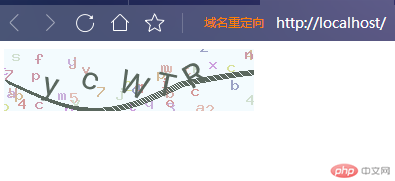 PHP Framework
PHP Framework
 ThinkPHP
ThinkPHP
 Simplify think-captcha verification code under ThinkPHP6 and improve text recognition
Simplify think-captcha verification code under ThinkPHP6 and improve text recognition
Simplify think-captcha verification code under ThinkPHP6 and improve text recognition
As we all know, the verification code can prevent malicious login registration. It is generated by the server, sent to the client, and finally displayed in image format. Complex verification codes can improve the security of the website, but overly complex verification codes will also make it extremely difficult to recognize text with the naked eye, greatly reducing the user experience.
This article uses the latest thinkphp6.0think-captcha extension as the modification object to explain in detail how to simplify the display of verification codes, improve text recognition, and make the elderly People can see clearly too!
think-captcha verification code
Controller test code:
<?php
namespace app\controller;
use app\BaseController;
use think\facade\View;
class Index extends BaseController
{
public function index()
{
return View::fetch();
}
}View test code :
<!DOCTYPE html>
<html lang="en">
<head>
<meta charset="UTF-8">
<title>Title</title>
</head>
<body>
<img src="/static/imghw/default1.png" data-src="{:captcha_src()}" class="lazy" alt="">
</body>
</html>The verification code rendered by default is as follows:

Some friends may think this is very clear, but for older people It is still difficult for older people. In addition, by modifying the verification code file, you can also improve your hands-on ability and increase your knowledge.
Optimize think-captcha verification code
Find the config\captcha.php configuration file and modify the following parts:
//验证码位数 'length' => 4, //简洁的4字符验证码 // 验证码字符集合 'codeSet' => '0123456789', //这里我去掉英文了,只留下数字部分 // 是否使用混淆曲线 'useCurve' => false, //是否添加杂点 'useNoise' => false, // 验证码字体 不设置则随机 'fontttf' => '4.ttf', //经测试,该字体很顺眼
Refresh after modification to see if it is more concise?

This is actually quite good. Under normal circumstances, it is not recommended to modify the framework, but for the purpose of learning, we will further optimize it.
Openvendor\topthink\think-captcha\src\Captcha.php
Modify line 277 and remove the font tilt
imagettftext($this->im, $this->fontSize, 0, $x, $y, $this->color, $fontttf, $char);
Finally take a look at the effect, are you satisfied?

This article simplifies the display of the verification code and improves the performance by simply modifying the configuration file and removing the inclination. Regarding text recognition, friends, the more you practice, the more profound your impression will be!
The above is the detailed content of Simplify think-captcha verification code under ThinkPHP6 and improve text recognition. For more information, please follow other related articles on the PHP Chinese website!

Hot AI Tools

Undresser.AI Undress
AI-powered app for creating realistic nude photos

AI Clothes Remover
Online AI tool for removing clothes from photos.

Undress AI Tool
Undress images for free

Clothoff.io
AI clothes remover

Video Face Swap
Swap faces in any video effortlessly with our completely free AI face swap tool!

Hot Article

Hot Tools

Notepad++7.3.1
Easy-to-use and free code editor

SublimeText3 Chinese version
Chinese version, very easy to use

Zend Studio 13.0.1
Powerful PHP integrated development environment

Dreamweaver CS6
Visual web development tools

SublimeText3 Mac version
God-level code editing software (SublimeText3)

Hot Topics
 How to run thinkphp project
Apr 09, 2024 pm 05:33 PM
How to run thinkphp project
Apr 09, 2024 pm 05:33 PM
To run the ThinkPHP project, you need to: install Composer; use Composer to create the project; enter the project directory and execute php bin/console serve; visit http://localhost:8000 to view the welcome page.
 There are several versions of thinkphp
Apr 09, 2024 pm 06:09 PM
There are several versions of thinkphp
Apr 09, 2024 pm 06:09 PM
ThinkPHP has multiple versions designed for different PHP versions. Major versions include 3.2, 5.0, 5.1, and 6.0, while minor versions are used to fix bugs and provide new features. The latest stable version is ThinkPHP 6.0.16. When choosing a version, consider the PHP version, feature requirements, and community support. It is recommended to use the latest stable version for best performance and support.
 How to run thinkphp
Apr 09, 2024 pm 05:39 PM
How to run thinkphp
Apr 09, 2024 pm 05:39 PM
Steps to run ThinkPHP Framework locally: Download and unzip ThinkPHP Framework to a local directory. Create a virtual host (optional) pointing to the ThinkPHP root directory. Configure database connection parameters. Start the web server. Initialize the ThinkPHP application. Access the ThinkPHP application URL and run it.
 Which one is better, laravel or thinkphp?
Apr 09, 2024 pm 03:18 PM
Which one is better, laravel or thinkphp?
Apr 09, 2024 pm 03:18 PM
Performance comparison of Laravel and ThinkPHP frameworks: ThinkPHP generally performs better than Laravel, focusing on optimization and caching. Laravel performs well, but for complex applications, ThinkPHP may be a better fit.
 Development suggestions: How to use the ThinkPHP framework to implement asynchronous tasks
Nov 22, 2023 pm 12:01 PM
Development suggestions: How to use the ThinkPHP framework to implement asynchronous tasks
Nov 22, 2023 pm 12:01 PM
"Development Suggestions: How to Use the ThinkPHP Framework to Implement Asynchronous Tasks" With the rapid development of Internet technology, Web applications have increasingly higher requirements for handling a large number of concurrent requests and complex business logic. In order to improve system performance and user experience, developers often consider using asynchronous tasks to perform some time-consuming operations, such as sending emails, processing file uploads, generating reports, etc. In the field of PHP, the ThinkPHP framework, as a popular development framework, provides some convenient ways to implement asynchronous tasks.
 How to install thinkphp
Apr 09, 2024 pm 05:42 PM
How to install thinkphp
Apr 09, 2024 pm 05:42 PM
ThinkPHP installation steps: Prepare PHP, Composer, and MySQL environments. Create projects using Composer. Install the ThinkPHP framework and dependencies. Configure database connection. Generate application code. Launch the application and visit http://localhost:8000.
 How is the performance of thinkphp?
Apr 09, 2024 pm 05:24 PM
How is the performance of thinkphp?
Apr 09, 2024 pm 05:24 PM
ThinkPHP is a high-performance PHP framework with advantages such as caching mechanism, code optimization, parallel processing and database optimization. Official performance tests show that it can handle more than 10,000 requests per second and is widely used in large-scale websites and enterprise systems such as JD.com and Ctrip in actual applications.
 Development suggestions: How to use the ThinkPHP framework for API development
Nov 22, 2023 pm 05:18 PM
Development suggestions: How to use the ThinkPHP framework for API development
Nov 22, 2023 pm 05:18 PM
Development suggestions: How to use the ThinkPHP framework for API development. With the continuous development of the Internet, the importance of API (Application Programming Interface) has become increasingly prominent. API is a bridge for communication between different applications. It can realize data sharing, function calling and other operations, and provides developers with a relatively simple and fast development method. As an excellent PHP development framework, the ThinkPHP framework is efficient, scalable and easy to use.





